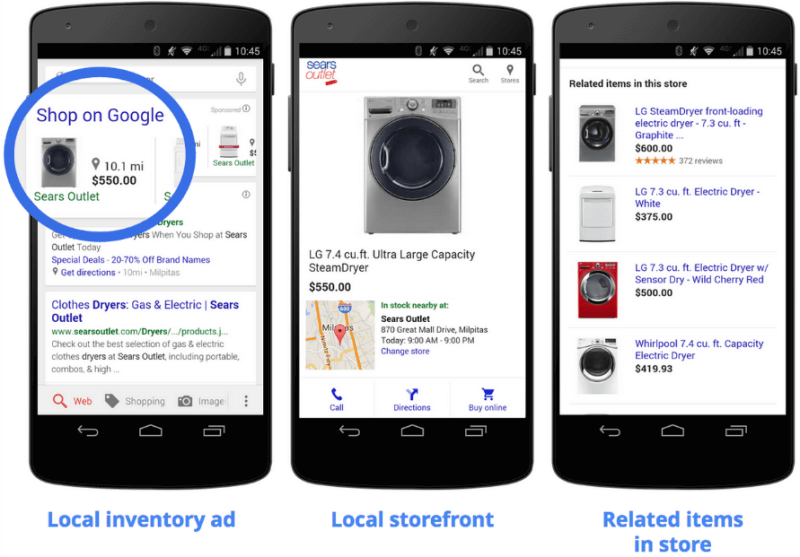Google Cites Local Inventory Ad Successes After Walmart Drops Out
Impact on in-store visits outperforms TV ads, says Sears Hometown & Outlet Stores.
Earlier this month, reports surfaced that Walmart had dropped out of Google’s Local Inventory Ads, signaling that the fledgling ad program may be struggling.
In apparent response, on Thursday, Google published a blog post highlighting case studies from two other major retailers having success with Local Inventory Ads.
Sears Hometown and Outlet Stores reported: 16 percent higher click-through rate; 122 percent increase in store visits after adopting Local Inventory Ads; $8 of in-store sales per dollar invested online.
“When we compared our most recent performance of local inventory ads to offline media typically used to drive store sales, such as a recent broadcast television campaign,” David Buckley, CMO at Sears Hometown and Outlet Stores told Google, “local inventory ads returned in-store sales at more than 5X the rate of TV advertising for each dollar spent.
Staples reported: Store visits rose by 33 percent; click-through rates increased by 29 percent after adding Local Inventory Ads.
“We know that more and more customers are doing research online before buying, and local inventory ads make it easier for us to reach small businesses and ensure we’re providing the most relevant offers,” Ellen Comley, Vice President of Integrated Media at Staples told Google.
Local Inventory Ads display in Google search results when products are available at nearby stores. They give consumers the price and distance to the store right in the ads.
Walmart’s decision to pull out of the program was apparently driven by the desire to protect its pricing information. That’s no small concern, particularly for a retailer whose value proposition is predicated on low prices. Walmart is also reportedly working on its own local inventory product. Why share store pricing data with Google when they can share it directly with consumers?
For Walmart to be successful on its own means steering consumer behavior to open a Walmart app instead of Google when they’re looking for products. That’s not easy, but not unprecedented, as Amazon has shown. More consumers go directly to Amazon to search for products than Google, as Eric Schmidt pointed out in a talk to the EU last year: “year almost a third of people looking to buy something started on Amazon — that’s more than twice the number who went straight to Google.”
Local Inventory Ads may be seeing slower adoption than Google Shopping did when it launched in 2012, but one retailer dropping out doesn’t mean the program is doomed.
Remember when Google relaunched Google Shopping as an entirely paid channel and Amazon declined to participate? Data-sharing sensitivity was a key reason for not signing on with Google product listing ads. There were similar discussions back then about whether Amazon’s lack of participation would impede the success of Google Shopping. We’ve seen how that turned out. Today, Google Shopping is most definitely a success, even without Amazon.
That said, participating in Google Local Inventory Ads is no small feat. It requires retailers to share huge batches of data with Google at demanding frequencies. Todd Bowman, head of Comparison Shopping Engine (CSE) and Feed Management at RKG, a Merkle company, points out that there are technical challenges that come with having to share that level of data — potentially millions of lines of data that includes inventory levels and pricing for every product in every store — with Google on an ongoing basis. “It’s hard for many retailers to share at that level.”
Despite challenges, if retailers like Staples and Sears Hometown and Outlet Stores continue to see positive results with Local Inventory Ads, I suspect Walmart dropping out will be a postscript just as Amazon now is in the story of Google Shopping.
Contributing authors are invited to create content for Search Engine Land and are chosen for their expertise and contribution to the search community. Our contributors work under the oversight of the editorial staff and contributions are checked for quality and relevance to our readers. The opinions they express are their own.
Related stories
